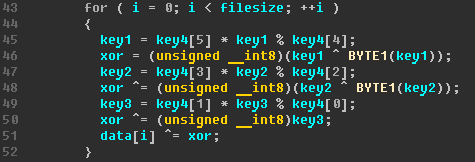
In April 2017, ShadowBrokers published their well-known ‘Lost in Translation’ leak, which, among other things, contained an interesting script that checked for traces of other APTs in the compromised system.
In 2018, we found an APT described as the 27th function of this script, which we call ‘DarkUniverse’. This APT was active for at least eight years, from 2009 until 2017. We assess with medium confidence that DarkUniverse is a part of the ItaDuke set of activities due to unique code overlaps. ItaDuke is an actor known since 2013. It used PDF exploits for dropping malware and Twitter accounts to store C2 server urls.
Technical details
Infection vector
Spear phishing was used to spread the malware. A letter was prepared separately for each victim to grab their attention and prompt them to open an attached malicious Microsoft Office document.
Each malware sample was compiled immediately before being sent and included the latest available version of the malware executable. Since the framework evolved from 2009 to 2017, the last releases are totally different from the first ones, so the current report details only the latest available version of the malware used until 2017.
The executable file embedded in the documents extracts two malicious files from itself, updater.mod and glue30.dll, and saves them in the working directory of the malware – %USERPROFILE%\AppData\Roaming\Microsoft\Windows\Reorder.
After that, it copies the legitimate rundll32.exe executable into the same directory and uses it to run the updater.mod library.
The updater.mod module
This module is implemented as a dynamic-link library with only one exported function, called callme@16. This module is responsible for such tasks as providing communication with the C2 server, providing the malware integrity and persistence mechanism and managing other malware modules.
The persistence mechanism is provided by a link file, which is placed by updater.mod into the startup folder, ensuring malware execution after a reboot. If the link file becomes corrupted, the updater.mod module restores it.
Communication with C2
In this campaign the C2 servers were mostly based on cloud storage at mydrive.ch. For every victim, the operators created a new account there and uploaded additional malware modules and a configuration file with commands to execute it. Once executed, the updater.mod module connected to the C2 and performed the following actions:
- downloaded the command file to the working directory;
- uploaded files collected and prepared by additional malicious modules (if any) to the C2. These files were located in a directory called ‘queue’ or ‘ntfsrecover’ in the working directory. Files in this directory could have one of two extensions: .d or .upd depending on whether they had already been uploaded to the server or not.
- downloaded additional malware modules:
- dfrgntfs5.sqt – a module for executing commands from the C2;
- msvcrt58.sqt – a module for stealing mail credentials and emails;
- zl4vq.sqt – legitimate zlib library used by dfrgntfs5;
- %victim_ID%.upe – optional plug-in for dfrgntfs5. Unfortunately, we were unable to obtain this file.
All malware modules are encrypted with a custom algorithm:
The credentials for the C2 account are stored in the configuration that is placed in the registry, but the updater.mod module also stores a copy as an encrypted string in the executable file. Also, the configuration specifies how often updater.mod polls the C2, supporting both an active mode and a partly active mode.
Malware configuration in the registry
The malware configuration is stored in the registry in the SOFTWARE\AppDataLow\GUI\LegacyP entry. Different values are detailed in the following table:
| Value name | Description |
| C1 | C2 domain. |
| C2 | C2 domain path. |
| C3 | C2 credential username. |
| C4 | C2 credential password. |
| install | 1 if malware is installed. |
| TL1 | DESACTIVAR | HABILITAR – specifies whether msvcrt58 and glue libraries are active. |
| TL2, TL3 | If TL1 is not NULL, it specifies time bounds when TL1 option is applied. |
| “kl” | If 1, updater.mod should download msvcrt58.sqt from C2 again. |
| “re” | If 1, updater.mod should download dfrgntfs5.sqt from C2 again. |
| “de” | If not 0, framework should uninstall itself. |
| “cafe” | REDBULL | SLOWCOW specifies how often updater.mod polls C2. |
| “path” | Path to the folder from which files are being sent to C2. |
Modules glue30.dll and msvcrt58.sqt
The glue30.dll malware module provides keylogging functionality. The updater.mod module uses the Win API function SetWindowsHookExW to install hooks for the keyboard and to inject glue30.dll into processes that get keyboard input. After that, glue30.dll loads and begins intercepting input in the context of each hooked process.
The msvcrt58.sqt module intercepts unencrypted POP3 traffic to collect email conversations and victims’ credentials. This module looks for traffic from the following processes:
- outlook.exe;
- winmail.exe;
- msimn.exe;
- nlnotes.exe;
- eudora.exe;
- thunderbird.exe;
- thunde~1.exe;
- msmsgs.exe;
- msnmsgr.exe.
The malware parses intercepted POP3 traffic and sends the result to the main module (updater.mod) for uploading to the C2. This is done by hooking the following network-related Win API functions:
- ws2_32.connect;
- ws2_32.send;
- ws2_32.recv;
- ws2_32.WSARecv;
- ws2_32.closesocket.
The dfrgntfs5.sqt module
This is the most functional component of the DarkUniverse framework. It processes an impressive list of commands from the C2, which are listed in the following table.
| Command | Description |
| VER | Sends malware version to server. |
| DESINSTALAR | Uninstalls itself. |
| PANTALLA | Takes screenshot of the full screen and saves it to the \queue folder. |
| CAN_TCP, CAN_HTTP, CAN_HTTPS | Injects a shellcode into IE that establishes a direct connection with the C2, downloads additional code, sends info about the download results to the C2 and executes the downloaded code. |
| MET_TCP, MET_HTTPS | Also injects a shellcode into IE. The only difference with the previous command set is that in this case the shellcode doesn’t send any additional info to the C2 – it only establishes the connection, downloads additional code and executes it. |
| CAN_HTTP_LSASS | Injects the same shellcode as in the case of CAN_HTTP into the LSASS.exe process. |
| SCAN/STOPSCAN | Starts/stops network scan. Collects lots of different info about the local network. |
| CREDSCAN | Brute-forces IP range with specified username and password. |
| ACTUALIZAR | Updates dfrgntfs5.sqt. |
| ACTUALIZARK | Updates msvcrt58.sqt. |
| SYSINFO | Collects full system info. |
| REDBULL | Sets cafe flag to 1 – active. |
| SLOWCOW | Sets cafe flag to 0 – slow mode. |
| X | Runs specified process and logs its output, then prepares this output log for uploading to the C2. |
| T | Obtains list of files from a specific directory. |
| TAUTH | Obtains list of files of remote server if specified credentials are valid. |
| G | Sends a file to the C2. |
| GAUTH | Downloads a particular file from a shared resource if specified credentials are valid. |
| SPLIT | Splits file into 400 KB parts and uploads them to the C2. |
| FLUSH | Sends file with the data collected by all components that day and deletes it. |
| C1 – C4 | Sets the C2 in its configuration in the registry (C1-C4). |
| TL1 – TL3 | Sets the active state in its configuration in the registry (T1-T3). |
| ONSTART | Sets process to be started every malware startup. |
| CLEARONSTART | Undoes previous ONSTART command. |
| ARP | Runs unavailable ARP module (uncparse.dll – unavailable). This module stores data in a file internally named arpSniff.pcap. |
| AUTO | Automatically looks for updates of predefined files. |
| MANUAL | Files in the specified directory are searched using the * .upd pattern, all found files are deleted. |
| REGDUMP | Collects information from the registry. |
| PWDDUMP | Collects and decrypts credentials from Outlook Express, Outlook, Internet Explorer, Windows Mail and Windows Live Mail, Windows Live Messenger, and also Internet Cache; |
| LOGHASH | Injects process into lsass.exe and starts collecting password hashes in the file checksums.bk. |
| SENDLOGHASH | Sends collected lsass.exe process password hashes to the C2. |
| PROXYINFO | Checks if credentials for proxy are valid. |
| DHCP | Sets DHCP settings for local machine. |
| DNS | Sets DNS settings for local machine. |
| FAKESSL | Provides basic MITM functionality. |
Victimology
We recorded around 20 victims geolocated in Syria, Iran, Afghanistan, Tanzania, Ethiopia, Sudan, Russia, Belarus and the United Arab Emirates. The victims included both civilian and military organizations. We believe the number of victims during the main period of activity between 2009 and 2017 was much greater.
Conclusions
DarkUniverse is an interesting example of a full cyber-espionage framework used for at least eight years. The malware contains all the necessary modules for collecting all kinds of information about the user and the infected system and appears to be fully developed from scratch. Due to unique code overlaps, we assume with medium confidence that DarkUniverse’s creators were connected with the ItaDuke set of activities. The attackers were resourceful and kept updating their malware during the full lifecycle of their operations, so the observed samples from 2017 are totally different from the initial samples from 2009. The suspension of its operations may be related to the publishing of the ‘Lost in Translation’ leak, or the attackers may simply have decided to switch to more modern approaches and start using more widely available artefacts for their operations.
Appendix I – Indicators of Compromise
MD5 Hashes
- 1addee050504ba999eb9f9b1ee5b9f04
- 4b71ec0b2d23204e560481f138833371
- 4e24b26d76a37e493bb35b1a8c8be0f6
- 405ef35506dc864301fada6f5f1d0711
- 764a4582a02cc54eb1d5460d723ae3a5
- c2edda7e766553a04b87f2816a83f563
- 71d36436fe26fe570b876ad3441ea73c
A full set of IOCs, including YARA rules, is available to customers of the Kaspersky Intelligence Reporting service. For more information, contact intelreports@kaspersky.com



















DarkUniverse – the mysterious APT framework #27